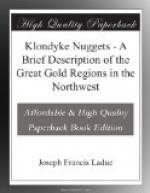“That part of the basin of the Yukon in which gold in greater or less quantities has actually been found lies partly in Alaska and partly in British territory. It covers an area of some 50,000 square miles. But so far the infinitely richest spot lies some one hundred miles east of the American boundary, in the region drained by the Klondyke and its tributaries. This is some three hundred miles by river from Circle City.
“We have described some of the beauties of the Yukon basin in the summer season, but this radiant picture has its obverse side.
“Horseflies, gnats and mosquitoes add to the joys of living throughout the entire length of the Yukon valley. The horsefly is larger and more poignantly assertive than the insect which we know by that name. In dressing or undressing, it has a pleasant habit of detecting any bare spot in the body and biting out a piece of flesh, leaving a wound which a few days later looks like an incipient boil. Schwatka reports that one of his party, so bitten was completely disabled for a week. ’At the moment of infliction.’ he adds, ’it was hard to believe that one was not disabled for life.’
“The mosquitoes according to the same authority are equally distressing. They are especially fond of cattle, but without any reciprocity of affection. ’According to the general terms of the survival of the fittest and the growth of muscles most used to the detriment of others,’ says the lieutenant in an unusual burst of humor, ’a band of cattle inhabiting this district, in the far future, would be all tail and no body, unless the mosquitoes should experience a change of numbers.’”
I am indebted to Wm. Ogilvie, Esq., for the following valuable information relative to The Yukon District.
“The Yukon District comprises, speaking generally, that part of the Northwest Territories lying west of the water shed of the Mackenzie River; most of it is drained by the Yukon River and its tributaries. It covers a distance of about 650 miles along the river from the coast range of mountains.




